The AnandTech Coffee Lake Review: Initial Numbers on the Core i7-8700K and Core i5-8400
by Ian Cutress on October 5, 2017 9:00 AM EST- Posted in
- CPUs
- Intel
- Core i5
- Core i7
- Core i3
- 14nm
- Coffee Lake
- 14++
- Hex-Core
- Hyperthreading
Benchmarking Performance: CPU Office Tests
The office programs we use for benchmarking aren't specific programs per-se, but industry standard tests that hold weight with professionals. The goal of these tests is to use an array of software and techniques that a typical office user might encounter, such as video conferencing, document editing, architectural modeling, and so on and so forth.
All of our benchmark results can also be found in our benchmark engine, Bench.
Chromium Compile (v56)
Our new compilation test uses Windows 10 Pro, VS Community 2015.3 with the Win10 SDK to compile a nightly build of Chromium. We've fixed the test for a build in late March 2017, and we run a fresh full compile in our test. Compilation is the typical example given of a variable threaded workload - some of the compile and linking is linear, whereas other parts are multithreaded.
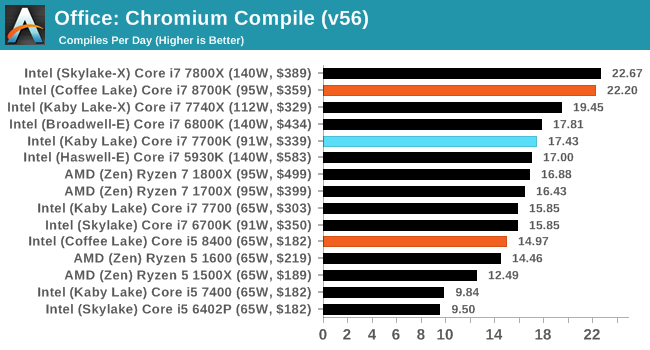
For our compile test, it would appear that the extra memory width afforded by the quad-channel memory of Skylake-X can have a direct benefit in compile performance.
PCMark 10
PCMark 10 is the 2017 update to the family favorite, PCMark 8. PCMark 8 has been part of our test bed since the latest update in Q1. For the most part it runs well, although for some processors it doesn’t recognize, some tests will not complete, leading to holes in our benchmark data (there’s also an odd directory quirk in one test that causes issues). The newest version, PCMark 10, is the answer.
The new test is adapted for more 2016/2017 workflows. With the advent of office applications that perform deeper compute tasks, or the wave of online gamers and streamers, the idea behind PCMark 10 is to give a better ‘single number’ result that can provide a comparable metric between systems. Single metrics never tell the whole story, so we’re glad that Futuremark provides a very detailed breakdown of what goes on.
Ganesh’s article on PCMark 10 goes into more detail than I will here, but the ‘Extended Benchmark’ runs through four different sets of tests: Essential, Productivity, Creation and Gaming. Each of these have sub-test results as well, including startup performance, web performance, video conferencing, photo/video editing, spreadsheets, rendering, and physics, which you can find in Bench.
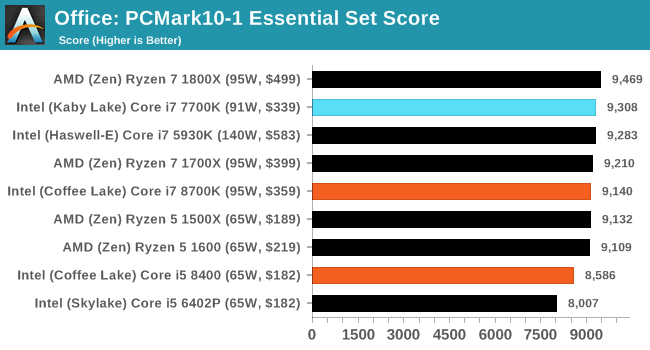

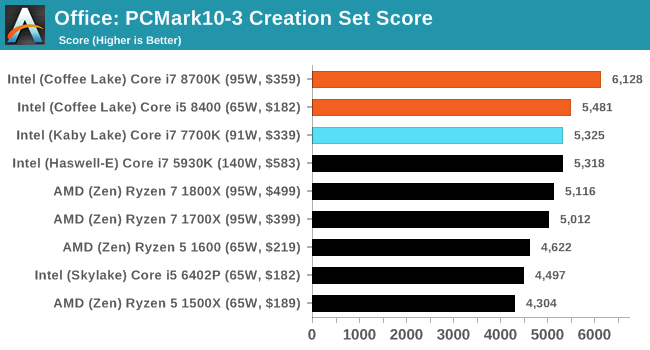
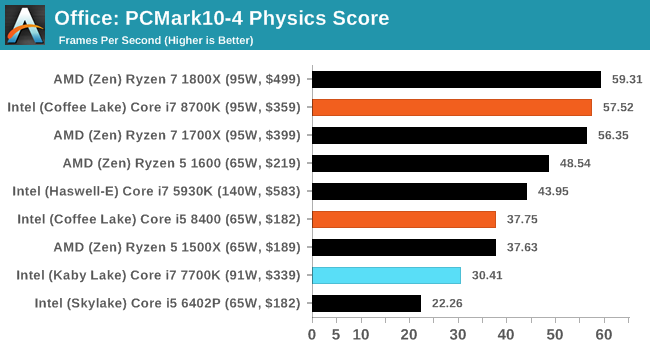
PCMark8: link
Despite originally coming out in 2008/2009, Futuremark has maintained PCMark8 to remain relevant in 2017. On the scale of complicated tasks, PCMark focuses more on the low-to-mid range of professional workloads, making it a good indicator for what people consider 'office' work. We run the benchmark from the commandline in 'conventional' mode, meaning C++ over OpenCL, to remove the graphics card from the equation and focus purely on the CPU. PCMark8 offers Home, Work and Creative workloads, with some software tests shared and others unique to each benchmark set.
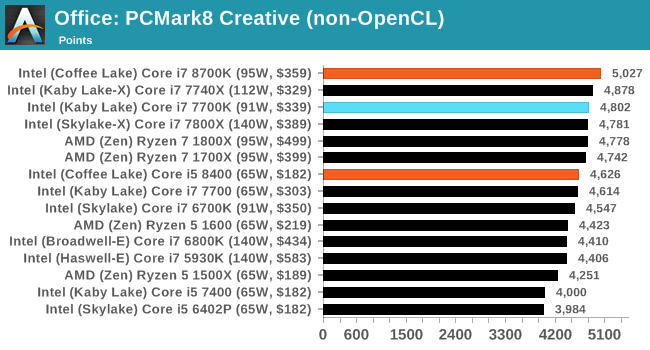
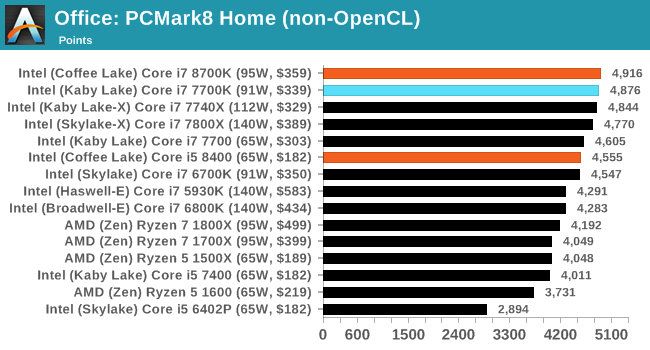
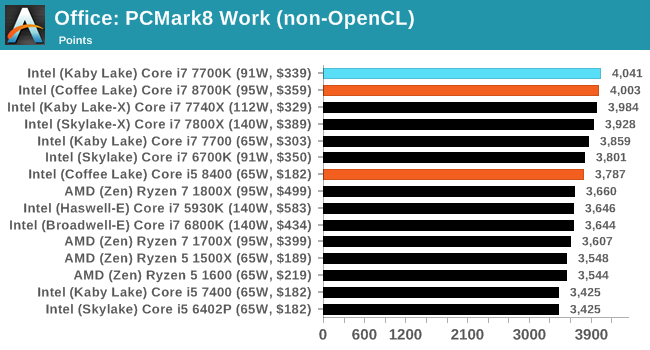










222 Comments
View All Comments
mapesdhs - Monday, October 9, 2017 - link
I'm not sure. :D It's certainly annoying though. Worst part is searching for anything and then changing the list order to cheapest first, what a mess...SunnyNW - Thursday, October 5, 2017 - link
"That changes today."Anyone else read that and think that it is something we should have been reading ages ago?
Consumer technology is progressing slower than many expected and I feel the same way. Nonetheless I can't help but envision a Very near future where I'll be coming back and reading this article and being depressed at this level of technology all the while on my future monolithic many thousand core 3D processor ;)
KAlmquist - Friday, October 6, 2017 - link
Yes. A year ago this would have been an exciting development. Now it's just Intel remaining competitive against AMD's offerings.Valcoma - Thursday, October 5, 2017 - link
"The Core i5-8400 ($182) and Core i3-8350K ($169) sit near the Ryzen 5 1500X ($189) and the Ryzen 5 1400 ($169) respectively. Both the AMD parts are six cores and twelve threads, up against the 6C/6T Core i5 and the 4C/4T Core i3. The difference between the Ryzen 4 1400 and the Core i3-8350K would be interesting, given the extreme thread deficit between the two."Those AMD parts are 4 cores, 8 threads.
Ian Cutress - Thursday, October 5, 2017 - link
You're right, had a brain spasm while writing that bit. Updated.kpb321 - Thursday, October 5, 2017 - link
Still off"The difference between the Ryzen 5 1500X and the Core i3-8350K would be interesting, given the extreme thread deficit (12 threads vs 4) between the two."
the 1500X is a 4c8t processor so it effectively has hyper-threading over the i3-8350K while having a lower overclocking ceiling and lower ipc.
Zingam - Saturday, October 7, 2017 - link
Drinking too much Coffee, eh?hansmuff - Thursday, October 5, 2017 - link
Ian, I love the way the gaming benchmarks are listed. So easy to access and much less confusing than drop-downs or arrows. Nice job!Valcoma - Thursday, October 5, 2017 - link
Are you sure that the i5-7400 got 131 FPS average in benchmark 1 - Spine of the Mountain in Rise of the Tomb Raider? Besting all the other vastly superior processors?Looks like a typing error there or something went wrong with your benchmark (lower settings for example on that run).
Ian Cutress - Thursday, October 5, 2017 - link
I've mentioned it in several reviews in the past: RoTR stage 1 is heavily optimized for quad core. Check our Bench results - the top eight CPUs are all 4C/4T. The minute you add threads, the results plummet.https://www.anandtech.com/bench/CPU/1827